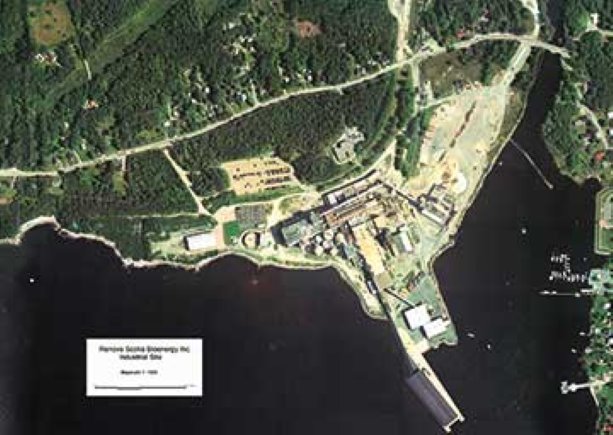Demolition continues on the massive Bowater Mersey Paper Company Limited complex in Brooklyn, N.S.
The facility opened in 1929 and was shut down in June 2012 by then-current owners Resolute Forest Products and the Washington Post Company, which relied on Bowater Mersey to provide newsprint.
Six months later, the province had brokered a deal to purchase the mill, a marine terminal, the Brooklyn Power Corporation’s biomass electrical plant and 550,000 acres of timber and commercial land for $1 in exchange for assuming $18 million in debt, pension liabilities for mill workers and environmental liabilities for the mill site. The province rechristened the operation as ReNova Scotia Bioenergy Inc.
A thorough assessment of the facility determined which buildings would be demolished and which could be revitalized into productive businesses.
“The site has very good infrastructure, its own industrial water supply, a power grid capable of delivering 100 megawatts, a good road and good docks,” says Joel MacLean, chief operating officer of Nova Scotia Lands, a Provincial Crown corporation that is overseeing the remediation and redevelopment of the property. “The thinking is that this could be transitioned into a viable industrial commercial park.”
Nova Scotia Lands had already overseen an environmental assessment and removal of 40 tonnes of asbestos and other controlled substances, including polychlorinated biphenyl light ballast, from the 66-acre industrial portion of the site. The asbestos removal contract was awarded to HRS Industrial and its sub-contractor, Asbestos Abatement Ltd. Decommissioning and monitoring the site is anticipated to cost $8.75 million over seven years, not including demolition or equipment removal.
Historically valuable site artifacts were removed and passed on to the Queens County Museum, the Nova Scotia Archives and to the Nova Scotia Museum of Industry.
The demolition contract was awarded through tender to the Dartmouth office of Tervita Corporation. Work began in mid-February.
“We’re targeting about one-third of the buildings on the site for demolition, most of which were built specifically for the paper mill,” says MacLean.
“For example, the paper mill building is several storeys tall but the floors were opened up to accommodate the equipment. There are also hydraulics and plumbing running though the floors. By the time you strip out the actual paper mill and other equipment, what you would have is a 1929 vintage building with holes in the floor and a poor heating system.”
The first building targeted was the acid plant where pulp was “cooked” to remove impurities. Other buildings being removed include: the roll finishing plant, where paper was trimmed and rolled for delivery; large masonry pulp tanks; the train shed; and the steam plant.
Much of the industrial equipment was sold at auction by Vancouver-based Maynards Industries in March, including motors, pumps, chip handling equipment, paper machines, and an 80-ton truck dumper. While smaller items could be transported from the premises, some of the demolition efforts have turned to strategic removal of walls to allow high bidders to remove large equipment purchases during a brief project pause in June.
Among the many structures being preserved: machine shops, the main office building, warehouse space and the original tunnel-and-conveyor belt system that once delivered paper products to the wharf.
“Many of the buildings are physically joined together, so one of the challenges of the demolition operation is carefully separating the buildings we want to keep from those we don’t, while maintaining the integrity of the remaining structure,” says MacLean.
Tervita is employing three, 45-ton excavators equipped with shear attachments for major demolition and three smaller excavators ranging from six to 30 tons to load scrap and debris. Many of the demolished buildings are masonry brick structures with steel and wood components. Much of the masonry is being crushed and used as backfill for the basements of demolished buildings.
Among the first tenants of the property is CelluFuel, which is establishing a petrochemical pilot plant designed to produce diesel from low-value wood fibre.
Demolition activities are expected to wind up before the end of 2014.

1/2
Photo:



Recent Comments
comments for this post are closed